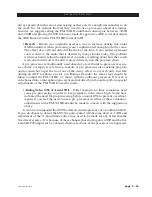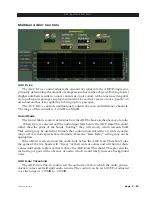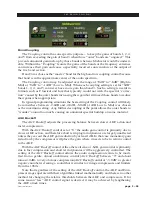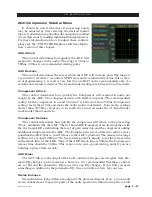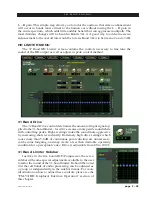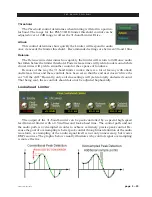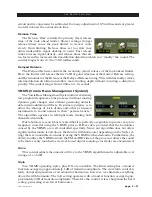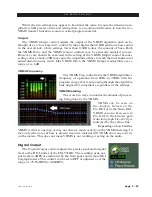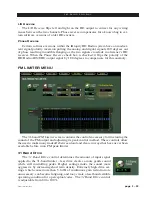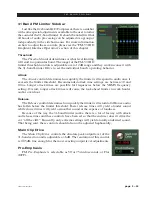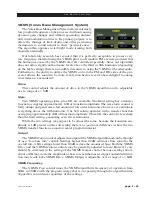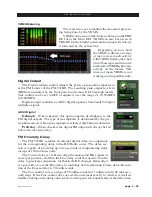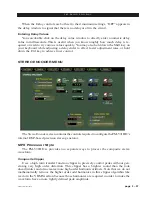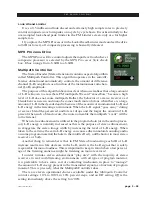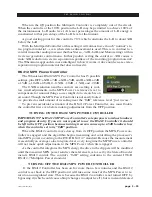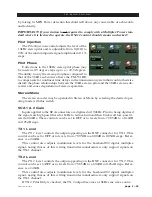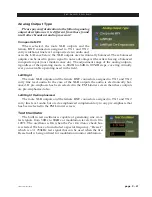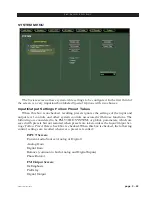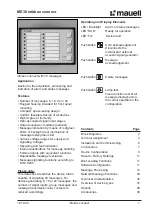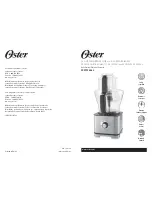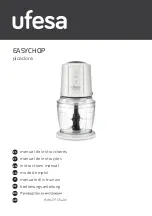
page 3 – 38
FM-531HD / May 2013
F M - 5 3 1 H D P R O G U I
Look Ahead Limiter
Uses a 0.5 millisecond look ahead and extremely high sample rates to precisely
control composite waveform peaks on a cycle by cycle basis. It works similarly to the
oversampled look ahead peak limiter in the FM Limiter screen, only at a far higher
sample rate.
If you place the MPX Processor in the Look Ahead Limiter mode and set the drive
to 0dB (or lower), all composite processing is basically defeated.
MPX Process Drive
The MPX Process Drive control adjusts the input level to whichever
composite processor is selected by the MPX Processor Style check
box. It has a range from ‑6.0dB to +6.0dB.
Multipath Controller
The Stereo Encoder (Stereo Generator) contains a special algorithm
called Multipath Controller. This algorithm operates in the sum/dif‑
ference domain and automatically controls the amount of difference
channel (L‑R) amplitude as a function of the instantaneous sum chan‑
nel (L+R) amplitude.
The purpose of this algorithm becomes clear when one realizes that a large amount
of L‑R is known to exacerbate FM multipath. We said “exacerbate” because a high
level of L‑R does not cause multipath. Rather, the behavior of a stereo receiver as it
blends between stereo and mono becomes much more obvious when there is a large
amount of L‑R in the decoded audio because of the acoustical summation of L+R and
L‑R energy in the listening environment. When the L‑R signal “goes away” during
a receiver blend the perceived audio level drops and the larger the amount of L‑R
present when such a blend occurs, the more noticeable the multipath “event” will be
to the listener.
When stereo enhancement is utilized in the program chain (or in the audio proces‑
sor) L‑R energy is naturally increased as this is the purpose of stereo enhancement,
to exaggerate the stereo image width by increasing the level of L‑R energy. When
taken to the extreme the extra L‑R energy can cause either unnatural sounding audio
on some program material (the hole in the middle effect), odd behavior in most stereo
receivers, or both.
Another thing to remember is that in FM Stereo broadcasting each dB of L‑R
increase results in a like decrease in the L+R, and it is the L+R signal that is solely
responsible for mono loudness. This is important to keep in mind when a fair percent‑
age of the listening audience might be listening on mono receivers!
In order to make stereo enhancement “play nice” with the majority of stereo
receivers in real‑world listening environments with all types of program material,
it is preferable to have some sort of controlling mechanism in place to “manage”
the amount of L‑R energy present in the transmitted signal as a function of program
material. This is precisely what the Multipath Controller does.
There are eleven operational choices available under the Multipath Controller
control settings: 10% to 100% in 10% percent steps, and an Off setting.
Off is the
setting immediately above the setting for 100%.
Summary of Contents for FM-531 HD
Page 2: ...Technical Manual Wheatstone Corporation May 2013 FM HD Digital Audio Processor FM 531hd...
Page 122: ...page A 2 FM 531HD May 2013 A P P E N D I C E S Appendix A General Specifications A 3 Contents...
Page 128: ...page A 8 FM 531HD May 2013 A P P E N D I C E S Appendix B FM 531HD GPI Interface A 9 Contents...

